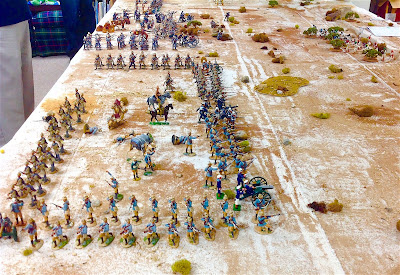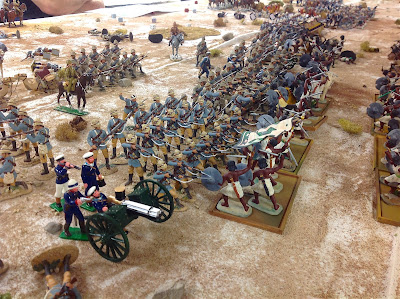 |
| British Heliograph & Signal Corps team and Indian screw gun (Little Legion 54mm toy soldiers) |
NOTE: click or double click all pictures to enlarge the view. They are spectacular when you look at the full size picture.
Yesterday six of us gathered in the cellar of Schloss Seewald to play with our toy soldiers, um I mean, to conduct a serious study and re-enactment of the Battle of El Teb, complete with all of the excruciating fine details.
Nah, we were just having some fun with our toy soldier collections. It is nice to get the big 54mm figures out on the tabletop every once in awhile because they are fun to play with and they photograph nicely. This was a real visual treat.
El Teb was fought in the eastern Sudan on February 24, 1884 between the British force commanded by Lt. General Sir Gerald Graham, VC. and the Mahdist forces commanded by the wily Osman Digna. Historically, the battle was a British victory and was also the first encounter with the Dervish. Enough of the potted history, let's get on with the wargaming! The story will be told through the picture captions of the pictures below.
 |
| British scouting outpost established to the east of Suakin. Its apparent isolation was to be the bait that would draw Osman Digna to battle. |
 |
| The view towards the village of El Teb as seen from the British outpost. |
 |
| Dervish camel riders observe the goings on in the British camp. |
 |
| A patrol of Camel Corps signal back to the camp that they have found Osman Digna's army. The Camel Corps mounted figures are from Red Box Miniatures and the foot soldiers are from Little Legion. |
A scouting patrol of Camel Corps was sent out into the desert from the outpost to see if they could find any signs of Osman Digna's army of Beja, Haddendowa and other Eastern Sudan tribes. These were the famed and fierce "Fuzzy Wuzzies", so named due to their distinct hair style.
With the location of Osman Digna's army, General Graham ordered the brigades of Sinclair (newly promoted to brigadier general from colonel) and Sir Charles Barclay to advance towards El Teb and attempt to attack the Dervish on their left flank. Sinclair's brigade square would lead the advance, with Barclay's brigade square initially "refused" on the right flank.
 |
| Captured Krupp gun and Egyptian gun crew overseen by several Dervish to provide "encouragement". This gun played havoc on the British forces as they marched towards El Teb. |
This sole gun seemed to have Sinclair's Brigade zeroed in with its sites all day and I lost the majority of my casualties from the artillery fire of this one gun. Yikes! I don't care to run into that death machine again. My Gatling Guns did not have the range to reply to the Krupp's fire for several turns. So I sent a company of skirmishers out ahead of the square and they were able to mow down 3 of the 4 gun crew (the Dervish officers having bolted before the British skirmishers fired), causing the Krupp to fall back below the crest of the ridge where they were deployed.
 |
| An abandoned sugar refinery - the boiler is all that remains, but the site provides good cover for Dervish riflemen. |
 |
| A close up (a Selfie?) picture of one of the Navy Gatling Guns (Trophy Miniatures) and the Camel Corps. |
 |
| Bill Protz sets up the second square of British infantry: Marines Light Companies, Naval Ratings (sailors), and several companies of Black Watch and Gordon Highlanders. |
One of the Dervish players (scheduled as such) asked if he could have a British command, so we carved out a few units of Camelry and Sudanese regulars for him, also giving him most of our artillery pieces to game with. He did a rather fine job of holding down the British right flank against overwhelming Dervish numbers, although by the end of the game, the Dervish were about to move into the British camp.
 |
| A small Sudanese command in the Imperial service. Approximately 35 figures consisting of Aylmer and Trophy Miniatures figures. |
 |
| An overhead view of the British squares forming up. Sinclair's square is in the foreground and Colonel Barclay's second square is forming up in the background. |
 |
| Barclay's square begins its advance across the tabletop. Figures are from Britains and John Jenkins Designs. A few single King & Country personality figures are sprinkled in amongst the troops |
It took the two British squares maybe four turns to advance towards the center of the table. We halted our advance in front of the ridge where the Krupp gun had been deployed, figuring that the whole Dervish army must be hidden on the other side of the ridge.
And they were:
 |
| The first wave of Dervish attack Sinclair's square and are largely whittled down by gun fire before they can get within melee range. The Beja are easily driven off. |
 |
| But this is different! A wave of fierce Beja and Hadendowa warriors crash into the York and Lancaster Regiment. Many of the Beja warriors are plastic figures from Armies in Plastic. |
We were feeling rather cocky at this point in the game, having driven off two major Dervish attacks. It was then that the Mahdists remembered that they had a large contingent of River Arabs, perhaps as much as 25% of their entire army. I allowed them to have the Arabs arrive at ANY point along the table edge and how do you think that they repaid my kindness? Why of course, sending them ALL after Sinclair's command (me). I felt like the poor colonel in the Normandy beach bunker when he first sees the allied invasion fleet in front of them - THEY ARE ALL COMING AT ME!!!!!!
The British had little in the way of reserves that could be used to shore up the right flank, save for the squadron of the 21st Lancers. Sinclair cobbled a weak defensive line facing to the right, hoping to at least slow down the expected Arab assault. The Lancers would have to pull a forelorn hope charge into the Arab infantry (well it worked for Winston Churchill at Omdurman) with the hope of scattering them before they could attack.
You can see the awfullness in the pictures below.
 |
| A few scattered remnants of the Camel Corps and the York & Lancaster regiment throw up a last ditch defensive position on the army's right flank. These are desperate times! |
 |
| The Arabs commence their advance around the right flank of the British. |
Who won? I can't say for certain, but we all had fun playing the game, so everyone was a winner in my book.
 |
| One of the hazzards of playing with toy soldiers - a good solid bump of the table with one's knee can send a line of troops tumbling into the sand. The 21st Lancers are Britains figures. |
The Butcher's Bill: I didn't keep track of the Dervish casualties but in my own brigade of around 100 figures I lost 45 killed or wounded or missing. That is a fairly high casualty percentage and reflects the number o melees that I was in. Approximately 15 casualties were sustained from the Krupp gun before I could even close with the Dervish. I think that Bill suffered a similar percentage of casualties in his brigade.
York and Lancaster Regt. = 19 casualties out of 60 figures
Camel Corps = 22 casualties out of 46 figures
Naval Crew = 4 casualties out of 8 figures (one gun was wiped out- 4 figure crews)
The Next Day: This morning, rather than putting all of my soldiers away in their boxes, I decided to set up a diorama of a British square under attack from the Dervish. I will leave this setup for a week or so and then take it down so that I can set up some European scenary for 28mm Seven Years War games.
 |
| This morning, after clearing the battle debris off of the table, I set up a new square of just my troops: York & Lancaster Regiment and the Camel Corps. |







Marvelous looking spread, Jim! Say, must the English always fight from square? Hardly sporting!
ReplyDeleteAll is fair in love and War. 😀
DeleteFantastic! I love to see the 54mm's hit the table from time to time. We sometimes use them for AWI and ACW.
ReplyDeleteThank you Rod. Hmm, AWI...
DeleteJust magnificent.
ReplyDeleteFritz you exhaust my arsenal of superlatives.
Try supercalifragilisticexpeallidotious!
DeleteI am grateful for the opportunity Jim, to have been part of this extraordinary and unique game. It was visually striking, our gamer friends excelled in comradeship, it was fun and chow was good too. Had we played on, the 21st Lancers would have charged the Arabs to support your right flank. Thoughts are percolating for the next time. Thank you, Bill
ReplyDeleteI can hardly wait for the next game - see Ross's suggestion below.
DeleteLovely, especially the abandoned sugar refinery shot.
ReplyDeleteThat was made by Herb Gundt, which I forgot to mention.
DeleteCracking looking game and nice to knw you all enjoyed yourselves:)
ReplyDeleteYes, it was quite the good tonic to lift my spirits. I love the visual and socializing aspects of a good Wargame.
DeleteJust the thing to peruse on an early Monday morning! Looks like the game was terrific fun all around. Happy to see you back in the thick of tabletop things.
ReplyDeleteBest Regards,
Stokes
Thank you Stokes. I'm just happy that you are here after hearing about your weekend mishap with an erratic driver.
DeleteMarvellous !
ReplyDeleteThank you Allan. There is nothing like a steady British square to get the gaming mojo going.
DeleteMarvelous pictures! Hurrah for the camelry!
ReplyDeleteSounds like an exciting game.I wonder how the British would do in a refight of Kirbekan?
That's a great idea Ross. I'm going to start working on a Kirbekan scenario.
DeleteFine looking set to there! The big chaps certainly bring something different to a game.
ReplyDeleteExcellent display of fine soldiers Bill, for sharing with us all.
ReplyDeleteCheers,
Willz
A good dusting was had by the look of it. A joy to see Jim
ReplyDeleteI seem to recall from a history of the campaign (Churchill's, I think) that the Dervishes actually used captured Egyptian gunners, actually chaining them to the guns so they couldn't run away.
ReplyDeleteWonderful set up, really enjoyable
ReplyDeleteCheers
Paul